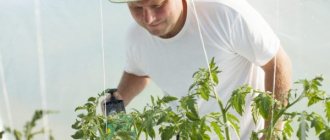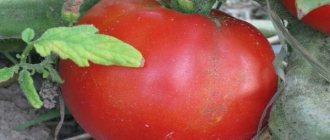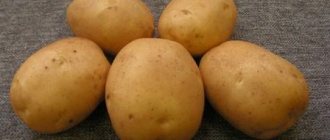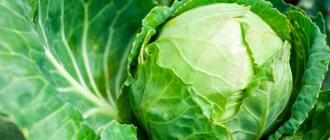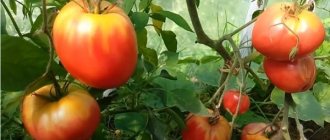Pros of technology
It would seem that there is a vegetable garden where you can grow any variety, but people stubbornly strive for the exotic. Tomatoes hung with their roots up look not only exotic, but also aesthetically pleasing. By choosing varieties with fruits that are orange like lanterns, or light bulb shaped, red balls or ovals, you can decorate any place with them. If the variety has an extended growing season, then the pleasure will last until frost. Then the suspended structure can be moved into the house and prolong the pleasure.
But the people are right, as always, and this technology allows:
- To have a harvest where it is not possible to plant a vegetable garden, because such planting does not require any land space;
- Use the space above the garden. By building a support over the strawberries, you can hang the tomatoes and get a harvest;
- Grow crops on loggias and balconies in the absence of window sills, using free space;
- Receive crops all year round indoors;
- Use of the upper, unused areas of greenhouses and greenhouses;
- When planting upside down, there is no need for support systems;
- There is no need for hilling and weed control;
- Tomatoes with this technology do not grow as stepsons; the more magnificent the bush, the higher the yield and the more interesting the design;
- Using similar technology, you can build a screen and cover your personal space from prying eyes;
- To reap the harvest, all you have to do is reach out your hand;
- Not every adult understands this miracle of nature, but children are simply delighted and perceive caring for the plant as fun.
Vertical growing methods
A garden plot can become a place for active recreation if you use some vertical growing techniques.
Tomato bushes can be placed anywhere on the site, near the house, along the fence, in a resting place. Plants love light, so the area should be sunny. Vertical farms are not used for growing tomatoes. It is more convenient to sow in them to obtain seedlings.
- Tomatoes are grown in a barrel. It contains a drainage layer of expanded clay and gravel and is filled with nutritious and loose soil mixture.
- Instead of a barrel, you can use decorative containers or flower pots. This method is relevant for growing vegetables at home.
- To make the garden bed mobile, use bags, sacks and packages. You can plant several bushes in them by making side holes. If necessary, a bag or sack can be brought from an open area into a greenhouse or indoors.
Bags for growing tomatoes must be durable. The vertical method of planting tomatoes in a limited space was first founded by African plant growers. This is due to the lack of large areas of fertile soil.
The bushes must be decorated and tied up so that the stems and fruits are well ventilated. Trellis and nets are installed in a standard horizontal or vertical bed. Only the root remains in the soil. The entire green part of the plant is located vertically.
We recommend: How to grow strawberries in vertical hydroponics?
For hydroponics, bags and packages are placed in trays, which have a system for draining the nutrient solution. For growing at home, containers with plants are installed in a grow box. To form bushes in the boxes, a grid is provided.
The stem and branches are passed into the cells of a mesh or trellis. The result is a green wall or carpet on which the fruits are evenly distributed. When using vertical tying of plants, there is no need to bend down to the ground to remove shoots or dry leaves.
Plants on a trellis rarely get sick. It is convenient to care for and harvest. In the grow box, voluminous tomato bushes are placed comfortably and develop well. All fruits are well lit and heated. The fruiting period is long.
In a greenhouse or at home, it is more convenient to use hydroponic installations for growing tomatoes. The installation can also be located in an open area. An option with multi-level hydroponics is possible.
Tomatoes are planted in horizontal modules, which are located on the sides of the pyramid. Purchase installations in the shape of the letter “A” or “V”. To prevent plants from interfering with each other’s development, horizontal nets are provided for the stems. Branches and fruits are laid on them.
Low-growing varieties of tomatoes are planted in pots with cache-pots, which are hung on hooks or on vertical stands. Tomatoes are grown using hydroponic deep water culture technology.
The design is voluminous. A nutrient solution is collected in a pot, a spray stone is placed, through which air is supplied to the roots of the plant. The stone is connected to an aquarium compressor.
The pots are filled with expanded clay and one tomato bush is planted. Low-growing varieties do not form long stems and branches. A bush in a flower pot looks like a green hat.
Excess stepsons are removed so as not to thicken the plantings. With a nutrient solution, the plant develops faster and bears fruit for a long time. Tomatoes in pots will serve as a decorative element on the site or indoors.
To prepare a hydroponic solution, use Flora Series concentrates from GHE. Before the flowering period, the following proportions are adhered to: Grow 19 ml/10 l, Micro 25 m/10 l, Bloom 12.5 ml.
During flowering and until the end of the growing season, the norms change: Grow 19 ml/10 l, Micro 25 m/10 l, Bloom 15.5 ml. The nutrient solution is renewed every week.
Secrets of technology and varieties
All secrets are based on the fact that the plant wants to grow vertically and reach for sunlight. No matter how we plant or rotate the pot, the tomato will in any case want to grow upward.
In this technology, the variety matters. You cannot plant any variety or hybrid you like, or even one that has been tested many times. Preference should be given to those whose shoots are thin, vine-like, and whose fruits are not large.
If you choose pink tomatoes, then the “Pearl” variety is suitable, its shoots are thin and, when tied in time, will seem to wrap around the pot. "Red Hunter" has fruits like small pears, and the bushes are very straggling. Clusters with yellow fruits are continuously formed in the “Wagner Mirabelle” variety.
If you prefer resistant varieties so as not to carry out processing, then you need to sow the hybrid “Ampel F 1”. If you like tomatoes similar to black currants, then the “Black Bunch” variety will surprise even experienced vegetable growers.
Separately, you need to sow the Rapunzel variety. Huge brushes that carry up to 50 tomatoes look very beautiful. They do not ripen at the same time, and those that ripen remain marketable for a long time.
If you have already tried these varieties, then you can give preference to “Cherry”, “Roma”, “Arctic”, “Talisman”.
What is the essence of technology
For our compatriots, this technology is not very familiar, but once you see this beauty in the garden, you want to decorate your plot with it.
Why is the harvest richer if this method is used? This can be explained by better ventilation of the escape and, most importantly, less stress. True, not all varieties are suitable for this technology. Miniature tomatoes and tomatoes that can be grown in containers are what you can really grow upside down.
These tomatoes are grown in a variety of containers, but the most commonly used are 20-liter plastic buckets with a handle. Watering and fertilizing the plant is not difficult - we reach with a watering can from above and water it like flowers. And often gardeners grow herbs there, on the same level as tomatoes. It is both beautiful and practical.
Selection of containers
Each technology has its own characteristics. In this case, the pot must be at least 5 liters. You won't be able to get a beautiful crop in a small hanging pot. Only a bush that has a voluminous vegetative mass and a lot of fruits will look beautiful, and for this you need a good root system.
When choosing a container for planting, you can give preference to the following:
- plastic bucket. This container must be made of food-grade plastic or food-grade plastic. Since sunlight is necessary for cultivation, technical plastic, under its influence, can release toxic substances into the soil, and the root system absorbs the elements and transfers them to the fruits.
The bucket must certainly have a lid;
- Flasks made from water or other food products are also quite suitable. You can use plastic bottles with a capacity of 5 liters;
- Specialized gardening stores can offer a kit for growing vegetables using this “Topsy Torvi” technology (topsy-turvy).
If the containers have a lid, then there is no problem. If available materials are used, then it may be necessary to build a frame that will prevent the soil mixture from falling out.
Popular varieties
Producers pay much more attention to productive varieties compared to ornamental varieties. The assortment of specialized stores offers a small selection of seeds intended for cultivation in hanging pots. Let us dwell on the most common varieties and a description of their characteristics.
Garden pearl
Despite the name, the variety is suitable not only for home cultivation, but also for open ground. The compact size of the bushes (20-40 cm) and root system allows the use of a container with a volume of 3-5 liters. Creeping, branched shoots produce 300-500 pearl-pink tomatoes per season. The small size (15-20 g) is compensated by the pleasant sweet taste of tomatoes.
Ripe fruits are used for canning, decorating dishes and as a vitamin-rich snack. The variety does not require pinching; the harvest begins to ripen in 80-90 days. With proper agricultural technology, it continues to form ovaries until the onset of cold weather. In an apartment, harvesting can take several months. This requires regular fertilizing and a soil volume of at least 5-6 liters.
City dweller F1
An early hybrid, bred specifically for growing on city balconies and window sills. The stems grow up to 50-60 cm, so the optimal size of the growing container is 5-7 liters. Falling tassels produce bright red tomatoes weighing up to 30 g. The first harvest can be harvested after 3-3.5 months. The rate of maturation is influenced by the number of stepsons. The more lateral shoots there are on the bush, the later the fruits ripen.
The taste of ripe tomatoes is suitable for fresh consumption. The thick skin protects against cracking during heat treatment, so miniature tomatoes can be used for whole-fruit canning. The hybrid is resistant to diseases and is not afraid of drafts.
Cascade F1
An ampelous hybrid of tomatoes with drooping shoots. Up to 30 scarlet tomatoes are formed on one brush. There is a variety with yellow fruits (Cascade Yellow F1). It is distinguished by long stems reaching 100-120 cm, so the bushes should be placed at the appropriate height. Does not need to remove stepsons. Grows a branched bush strewn with fruit clusters.
It is recommended to grow the hybrid in hanging pots with a volume of 5 liters or more. A heavy bowl requires reliable fastening or a high pedestal. To increase productivity, it is necessary to feed the bushes at least 3 times per season.
Tumbling Tom Red F1
A variety of early ripening ampelous tomato for growing in the garden or on the balcony. The height of the bushes is 20-25 cm, while the length of the stems with fruit clusters hanging down is about a meter. The size of the plant differs depending on the size of the container. The minimum pot volume is 2.5 liters. You can enjoy sweet, red cherries after 2.5 months. The hybrid does not require formation, support and removal of stepsons. A prerequisite for growing is fertilizing and frequent watering.
Some gardeners prefer to plant ornamental varieties with flower crops together. As you can see in the photo, this method of growing becomes a real decoration of the site.
Mascot
An ampelous tomato variety, which is most common in our country. It grows in the garden and on the balcony, showing resistance to temperature fluctuations and drought. The first ripe tomatoes, weighing 15-20 g, begin to ripen after 90 days. Like all ampel varieties, it bears fruit for a long time.
Bushes up to half a meter high are covered with a scattering of red, slightly elongated tomatoes. Can be grown in open ground. One of the advantages is immunity to blossom end rot and late blight. The thick skin allows the tomatoes to remain intact during canning.
The ampel mixture of varieties from the company Aelita is popular among gardeners. The package contains planting material of the Thumbelina (red-fruited) and Vodopad (yellow-fruited) varieties. Sweet, aromatic cherries, intended for greenhouses, balconies and growing on windowsills.
Soil mixture for tomato
To prepare the soil you need to approach it with all responsibility. If you purchase a special soil mixture for tomatoes at a gardening center, then a tomato planted in it will not even require additional fertilizing. If you decide to prepare the soil yourself, then you cannot take it from the garden, especially from nightshades.
It is better to prepare the soil mixture in advance and combine it in the following proportion:
- compost - 1 part;
- rotted humus - 1 part;
- peat - 1 part.
Add 1 tbsp to the bucket of prepared mixture. a spoonful of superphosphate and 1 tbsp. a spoonful of ammonium nitrate.
Features of growing seedlings
The time for sowing tomato seeds for seedlings is completely different from ordinary tomatoes. Seedlings are also grown using classical technology, but in this case, stretching seedlings is to our benefit and there is no point in using growth inhibitors.
The secret to growing tomatoes upside down is that the plant needs a well-developed root system. If we plant a tomato 2-3 cm deep, then we will have to wait a very long time for the roots to envelop the soil.
Deep planting is a completely different matter. The tomato stem has the ability to grow roots over its entire surface, thus increasing the feeding area. This is exactly what needs to be achieved. If the height of a tomato plant is 30-40 cm, it needs to be buried as deep as possible, leaving 10-15 cm on the surface. The leaf plates simply come off.
Experienced vegetable growers, in order to speed up the process when growing seedlings, transfer them into a deep, but not wide container. A 1 liter milk carton with the top cut off is suitable for this purpose. After transshipment, the soil mixture is added and by the time of replanting the tomato plant has time to produce a huge number of roots.
You can't rush into this technology. We carry out replanting only when the earthen ball has completely “covered” the soil.
Secrets of technology
A good harvest of upside-down tomatoes depends on strict adherence to technological rules. Although in general they do not differ from the standard ones, they pay attention to a number of nuances.
Variety selection
Making the right choice is of utmost importance. Even a proven variety that has been tested for years when grown upside down does not give the desired result. Preference is given to tomatoes with thin, liana-like trunks, which under normal conditions require support and garter.
The size of the fruit is also important. It is best to use small-fruited species and cherry tomatoes. Experienced summer residents recommend the following varieties and hybrids:
- Pearl;
- Red Hunter;
- Wagner Mirabelle;
- Ampel F1;
- Black bunch;
- Roma;
- Arctic;
- Mascot.
Preparing containers
A prerequisite is sufficient volume. 5-liter pots, plastic bottles, and buckets are recommended. For very small tomatoes – low-growing cherry tomatoes – it is permissible to use 3-liter containers.
The following requirements apply to the container:
- Material: food grade plastic; metal is not recommended due to its heavy weight.
- The presence of a lid that protects against premature drying of moisture.
- The diameter of the hole in the bottom is 3-5 cm. It is easy to do it yourself; simply turn the bottles upside down, cutting off the bottom.
- The handles must withstand a load of 20 kg. For water containers, you can weave something like a net from cords.
Lazy summer residents use special kits for growing plants upside down, sold in specialized stores.
Priming
The soil is either purchased or prepared independently. In the first case, the best choice is a special mixture for tomatoes, which already contains all the substances necessary for growth and fruiting.
Your own nutrient substrate is prepared from compost, peat and humus, taken in equal volumes. To 10 liters of soil mixture add a tablespoon of superphosphate and ammonium nitrate. Mix everything thoroughly.
Seedlings for the inversion method
Sowing seeds and growing seedlings is carried out according to standard methods. The work is greatly simplified by the fact that there is no need to carefully illuminate the seedlings. Adherents of the topsy-turvy method claim that elongated stems are the key to a good harvest. All other activities are carried out according to the usual regulations.
Planting seedlings
It is more convenient to germinate seeds in peat tablets. The time for transplanting seedlings to a permanent place is determined by the roots: when they are completely entangled in the earthen ball, they can be relocated. If they are located in tablets, this moment cannot be missed.
There are two methods for planting seedlings. According to the first method, the container is first filled with soil mixture, then it is turned over and young plants are planted in the hole at the bottom. You can turn the pots over only when the tomatoes begin to grow.
In the second method, the container is already suspended. The seedling is carefully inserted into the hole at the bottom. Its roots are located inside, the stem with leaves is outside. Experienced gardeners recommend deepening them to 8-10 cm, so the tomato will quickly develop the territory and begin flowering.
The next step is the holding layer. The method uses sphagnum moss, dense thick fabric that allows moisture and air to pass through equally well, and mineral wool.
The third step is to carefully pour the substrate. At the same time, make sure that the roots do not wrinkle or break. A mulch layer is placed on the very top to prevent intense evaporation of moisture. At the same time, it will help maintain soil looseness. The best option is material for hydroponics.
The final stage is to hang the containers in well-lit places. The distance between them is maintained at 15-20 cm so as not to impede air circulation. Drafts are not allowed. This option is ideal for placing flippers in plastic bottles.
Tomato supports upside down
You need to take care of where and how to hang containers with tomato bushes in advance. A wide variety of objects and structural elements of country buildings can serve as supports for pots:
- Tree branches providing light shade.
- Walls, fences, where strong hooks are previously driven in.
- Crossbars adapted for heavy loads, for example, under the roof of a gazebo or terrace.
- Stairs and stepladders that have served their time, securely fixed in the soil.
- Flower trellises, pergolas, arches.
- Specially prepared wooden beams or metal pipes driven into the ground.
- Forged or cast flower stands look impressive, but this is an expensive pleasure that not everyone can afford.
The height of the supports should be such that it is convenient to water the suspended plants without placing a stool or stepladder.
Planting seedlings
If you use a plastic bucket, proceed as follows:
- A hole is made in the bottom of the bucket so that tomato seedlings can be planted in it without difficulty;
- The bucket is placed on the bottom, the hole is covered with film and filled with soil mixture;
- Closes with a lid and turns over;
- A hole is made in the film that covered the hole and tomato seedlings are planted into it;
- You cannot immediately turn the bucket over. After planting, 3-4 weeks should pass. During this time, the seedlings will fully take root and begin to develop the land. Experienced vegetable growers move on to the next stage only when they see clear signs that the tomato has begun to grow.
Disadvantages of the method
The disadvantages of this technology include:
- The need to construct a durable and strong suspension.
- It is not always possible to get a beautiful shape when a bush grows. The plant still tends to grow upward, so during cultivation the bushes may be unsightly.
- To form a large bush, you need at least 8 hours of sun. And the container in which the seedlings are planted initially gives a strong shadow, inhibiting normal development.
- If the summer turns out to be too hot and dry, then it is necessary to constantly water the tomatoes to ensure the necessary soil moisture.
- Not all crop varieties can grow in such conditions.
Sometimes it becomes difficult to find a hook or other place to hang the vessel. Of course, you can make a tripod yourself or buy it, but this entails some financial waste.
You may be interested in:
Method of growing tomatoes in buckets without a bottom The method of growing tomatoes in buckets without a bottom appeared at the end of the 20th century. Then they forgot about it and revived it not so long ago, years...Read more...
Supports for an air garden
Growing tomatoes upside down (roots) involves hanging the structure, and this must be taken care of in advance.
Forged tripods on which buckets with hanging tomatoes are hung look beautiful, but this design is very expensive. In any case, the main requirement for the design should be strength.
Hooks nailed to a fence or wall can serve as support. Branches and twigs of trees can also be used as a hanging garden.
Hammered wooden beams and flower arches, pergolas, may well serve as a place for a suspended structure.
Do everything very firmly so as not to lose the “garden”.
Advantages of the technique
This method of growing tomatoes has its advantages:
- the opportunity to get a high yield;
- saving space on the site;
- you can use the upper part of the greenhouse for this method of growing crops;
- the ability to carry an hanging vessel in case of bad weather;
- act as decoration;
- such tomatoes are less susceptible to diseases and pests;
- there is no need to install pegs for garters.
Such beds do not require loosening or weeding. It is enough just to water it in a timely manner and periodically check the soil. Watering itself is convenient because it is very similar to watering indoor flowers.
Care and watering
The plant does not require special care; weeds do not grow in it. Since the containers are constantly heated, drying out of the soil is a natural process and you need to carefully monitor it.
When hanging containers, you should take into account the moment of watering; therefore, there is no point in making the supports very high. Frequent watering also means frequent access to the plants, and it should also be convenient.
To facilitate the water filling process, you can cover the top with mulching material of both natural and synthetic origin.
If buckets with hanging tomatoes are located in one row, then craftsmen manage to carry out drip irrigation and this significantly solves the problem. A drop of water, dripping from the hole in the pipe located under the hanging handle, helps to constantly maintain the soil at optimal moisture.
If you don’t have experience yet, start with 1-2 plants, and with experience, the “garden” can be expanded. By choosing different varieties, you can transform your estate and diversify your holiday table.
